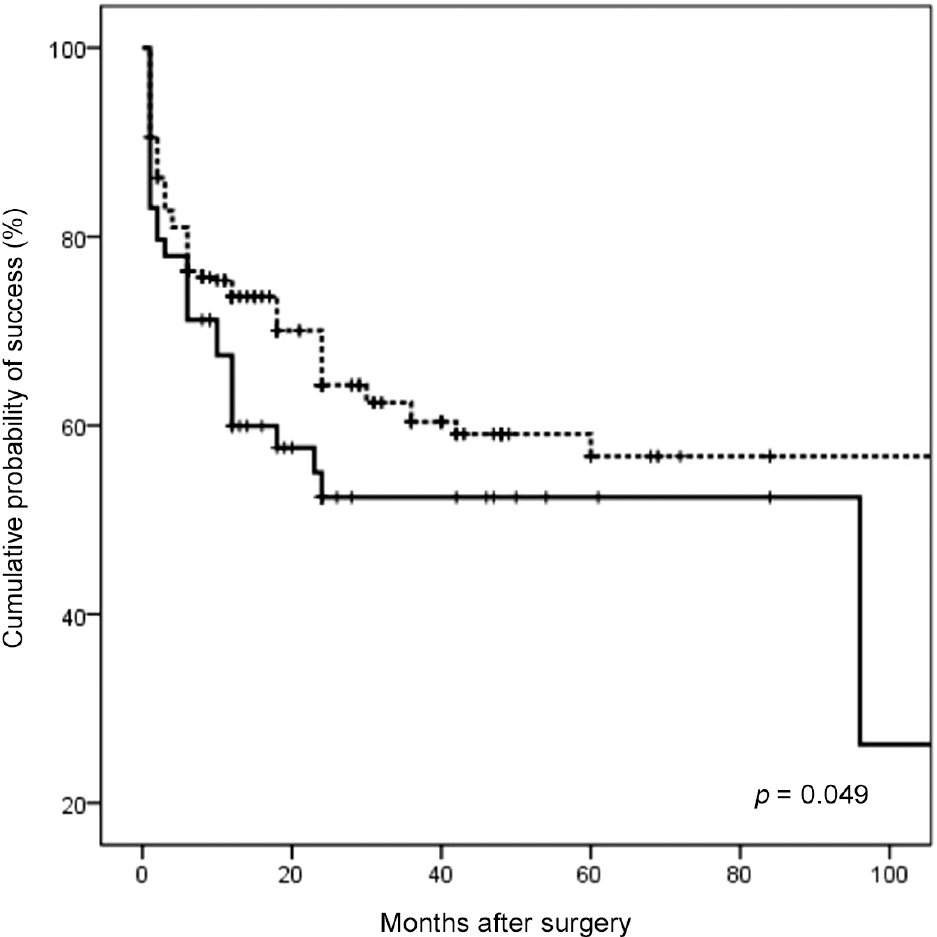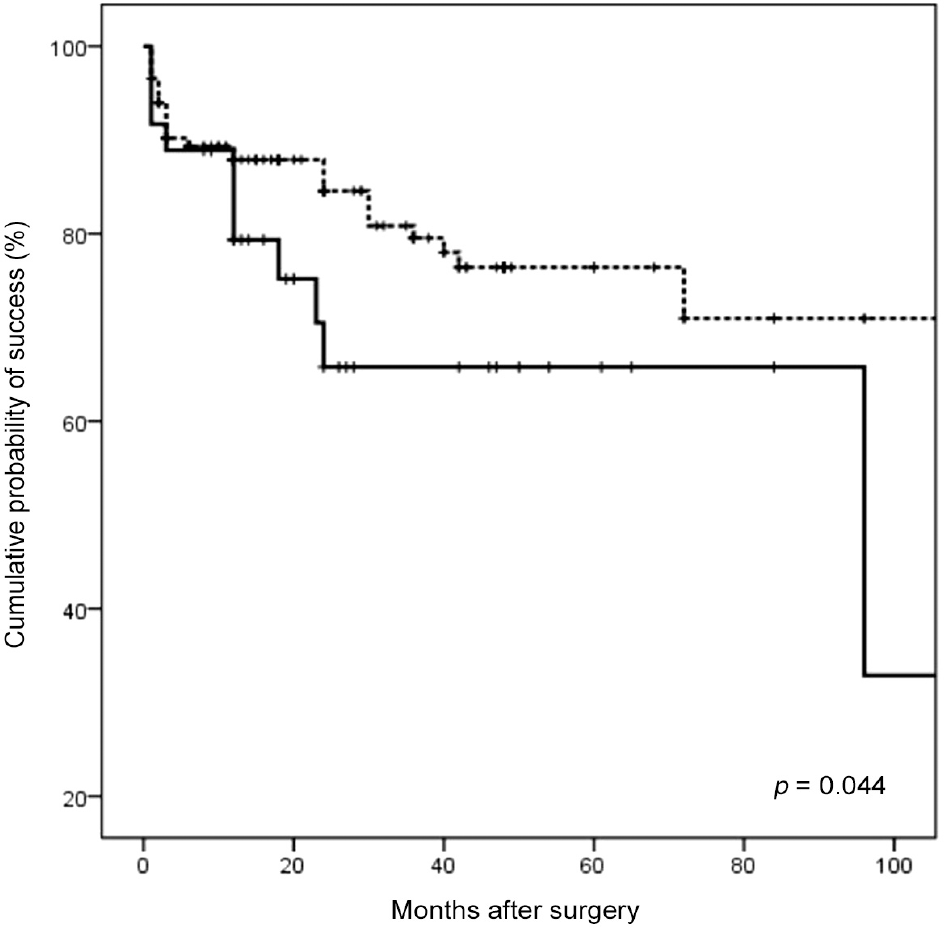Abstract
Purpose
In this study we evaluated the long-term outcomes and prognostic factors of trabeculectomy with mitomycin C (MMC) in eyes with uveitic glaucoma (UG) compared with primary open-angle glaucoma (POAG).
Methods
We performed a retrospective chart review of 60 eyes with UG and 402 eyes with POAG that were followed up for at least 1 year after trabeculectomy with MMC between June 2000 and December 2012. The review included intraocular pressure (IOP), number of anti-glaucoma medications, and postoperative complications. Surgical success was analyzed using the Kaplan-Meier life-table method based on 2 definitions of successful IOP control with topical anti-glaucoma medications: Definition A (IOP ≤ 15 mm Hg) and Definition B (IOP ≤ 18 mm Hg). Risk factors for surgical failure of trabeculectomy were ana-lyzed using the Cox proportional hazards model.
Results
Success rate at 5 years after trabeculectomy was lower in UG than in POAG (65.8% vs. 76.4%, Definition B), but with-out significant difference. However, UG had a significantly lower cumulative probability of success than POAG based on Kaplan-Meier survival curves ( p = 0.049 and 0.044, respectively). Postoperative hypotony and hypotony maculopathy was more frequent in UG ( p = 0.044 and 0.044, respectively). In UG, the Cox proportional hazards model showed postoperative shallow anterior chamber was associated with surgical failure in both Definition A and B.
References
1. Papadaki TG, Zacharopoulos IP, Pasquale LR. . Long-term re-sults of Ahmed glaucoma valve implantation for uveitic glaucoma. Am J Ophthalmol. 2007; 144:62–9.

3. Levene RZ. Glaucoma filtering surgery: factors that determine pressure control. Ophthalmic Surg. 1984; 15:475–83.
4. Skuta GL, Parrish RK. 2nd. Wound healing in glaucoma filtering surgery. Surv Ophthalmol. 1987; 32:149–70.

5. Cheung JC, Wright MM, Murali S, Pederson JE. Intermediate-term outcome of variable dose mitomycin C filtering surgery. Ophthalmology. 1997; 104:143–9.

6. Kitazawa Y, Kawase K, Matsushita H, Minobe M. Trabeculectomy with mitomycin. A comparative study with fluorouracil. Arch Ophthalmol. 1991; 109:1693–8.
7. Perkins TW, Gangnon R, Ladd W. . Trabeculectomy with mito-mycin C: intermediate-term results. J Glaucoma. 1998; 7:230–6.
8. Liebmann JM, Ritch R. Complications of glaucoma filtering surgery. Ritch R, Shields MB, Krupin T, editors. The Glaucomasglaucoma therapy. 2nd. St Louis: Mosby;1996. v. 3. chap. 84.
9. Noble J, Derzko-Dzulynsky L, Rabinovitch T, Birt C. Outcome of trabeculectomy with intraoperative mitomycin C for uveitic glaucoma. Can J Ophthalmol. 2007; 42:89–94.

10. Novak-Laus K, Mandić Z, Iveković R. . Trabeculectomy with mitomycin C in glaucoma associated with uveitis. Coll Antropol. 2005; 29:Suppl 1. 17–20.
11. Prata JA Jr, Neves RA, Minckler DS. . Trabeculectomy with mitomycin C in glaucoma associated with uveitis. Ophthalmic Surg. 1994; 25:616–20.

13. Palmer SS. Mitomycin as adjunct chemotherapy with trabeculectomy. Ophthalmology. 1991; 98:317–21.

14. Wright MM, McGehee RF, Pederson JE. Intraoperative mitomy-cin-C for glaucoma associated with ocular inflammation. Ophthalmic Surg Lasers. 1997; 28:370–6.

15. Iwao K, Inatani M, Seto T. . Long-term outcomes and prog-nostic factors for trabeculectomy with mitomycin C in eyes with uveitic glaucoma: a retrospective cohort study. J Glaucoma. 2014; 23:88–94.
16. Kaburaki T, Koshino T, Kawashima H. . Initial trabeculectomy with mitomycin C in eyes with uveitic glaucoma with inactive uveitis. Eye (Lond). 2009; 23:1509–17.

17. Hamanaka T, Takei A, Takemura T, Oritsu M. Pathological study of cases with secondary open-angle glaucoma due to sarcoidosis. Am J Ophthalmol. 2002; 134:17–26.

18. Ono T, Yuki K, Shiba D. . Postoperative flat anterior chamber: incidence, risk factors, and effect on the long-term success of trabeculectomy. Jpn J Ophthalmol. 2013; 57:520–8.

19. Bindlish R, Condon GP, Schlosser JD. . Efficacy and safety of mitomycin-C in primary trabeculectomy: five-year follow-up. Ophthalmology. 2002; 109:1336–41. discussion 1341-2.
20. Greenfield DS, Suñer IJ, Miller MP. . Endophthalmitis after fil-tering surgery with mitomycin. Arch Ophthalmol. 1996; 114:943–9.

21. Jacobi PC, Dietlein TS, Krieglstein GK. Adjunctive mitomycin C in primary trabeculectomy in young adults: a long-term study of case-matched young patients. Graefes Arch Clin Exp Ophthalmol. 1998; 236:652–7.

22. Shields MB, Scroggs MW, Sloop CM, Simmons RB. Clinical and histopathologic observations concerning hypotony after trabecu-lectomy with adjunctive mitomycin C. Am J Ophthalmol. 1993; 116:673–83.

23. Waheed S, Liebmann JM, Greenfield DS. . Recurrent bleb infections. Br J Ophthalmol. 1998; 82:926–9.

24. Toris CB, Pederson JE. Aqueous humor dynamics in experimental iridocyclitis. Invest Ophthalmol Vis Sci. 1987; 28:477–81.
25. de Smet MD, Gunning F, Feenstra R. The surgical management of chronic hypotony due to uveitis. Eye (Lond). 2005; 19:60–4.

26. Jampel HD, Pasquale LR, Dibernardo C. Hypotony maculopathy following trabeculectomy with mitomycin C. Arch Ophthalmol. 1992; 110:1049–50.

27. Stamper RL, McMenemy MG, Lieberman MF. Hypotonous mac-ulopathy after trabeculectomy with subconjunctival 5-fluorouracil. Am J Ophthalmol. 1992; 114:544–53.

28. Daugeliene L, Yamamoto T, Kitazawa Y. Cataract development af-ter trabeculectomy with mitomycin C: a 1-year study. Jpn J Ophthalmol. 2000; 44:52–7.

29. Husain R, Aung T, Gazzard G. . Effect of trabeculectomy on lens opacities in an East Asian population. Arch Ophthalmol. 2006; 124:787–92.

30. AGIS (Advanced Glaucoma Intervention Study) Investigators The Advanced Glaucoma Intervention Study: 8. Risk of cataract formation after trabeculectomy. Arch Ophthalmol. 2001; 119:1771–9.
31. Lazaro C, Benitez-del-Castillo JM, Castillo A. . Lens fluo-rophotometry after trabeculectomy in primary open-angle glaucoma. Ophthalmology. 2002; 109:76–9.

32. Popovic V, Sjöstrand J. Course of exfoliation and simplex glauco-ma after primary trabeculectomy. Br J Ophthalmol. 1999; 83:305–10.

33. Belfort R Jr, Nussenblatt RB. Surgical approaches to uveitis. Int Ophthalmol Clin. 1990; 30:314–7.

34. Foster CS, Fong LP, Singh G. Cataract surgery and intraocular lens implantation in patients with uveitis. Ophthalmology. 1989; 96:281–8.

35. Jampel HD, Jabs DA, Quigley HA. Trabeculectomy with 5-fluo-rouracil for adult inflammatory glaucoma. Am J Ophthalmol. 1990; 109:168–73.

Figure 1.
Kaplan-Meier curves for successful intraocular pres-sure (IOP) control by trabeculectomy with mitomycin C in pa-tients with uveitic glaucoma (UG, solid line) and primary open angle glaucoma (POAG, broken line). Definition of success of IOP control was IOP ≤ 15 mm Hg with medication (Definition A). Cumulative probability of success at 5 years was 52.4 ±0.1% in UG and 56.7 ± 0.1% in POAG ( p = 0.049, log-rank test).

Figure 2.
Kaplan-Meier curves for successful intraocular pres-sure (IOP) control by trabeculectomy with mitomycin C in pa-tients with uveitic glaucoma (UG, solid line) and primary open angle glaucoma (POAG, broken line). Definition of success of IOP control was IOP ≤ 18 mm Hg with medication (Definition B). Cumulative probability of success at 5 years was 65.8 ±0.8% in UG and 76.4 ± 0.3% in POAG ( p = 0.044, log-rank test).

Table 1.
Demographic characteristics according to types of glaucoma
| Characteristics | UG (n = 60) | POAG (n = 402) | p-value |
|---|---|---|---|
| Age (years, range) | 41.5 ± 11.4 (19-67) | 54.3 ± 15.3 (14-82) | 0.001* |
| Gender | 0.305† | ||
| Male (n, %) | 38 (63.3) | 281 (69.9) | |
| Female (n, %) | 22 (36.7) | 121 (30.1) | |
| Eye laterality | 0.888† | ||
| Right/left | 34/26 | 231/171 | |
| Preoperative BCVA | 0.53 ± 0.57 | 0.46 ± 0.56 | 0.560* |
| BCVA at final follow-up | 0.64 ± 0.63 | 0.51 ± 0.57 | 0.308* |
| Corneal endothelial cell density (cells/mm2) | 2,211 ± 419 | 2,454 ± 515 | 0.029∗ |
| Diabetes mellitus (n, %) | 8 (13.3) | 71 (17.7) | 0.592† |
| Hypertension (n, %) | 6 (10) | 60 (14.9) | 0.232† |
Table 2.
Preoperative and postoperative IOP and number of glaucoma medication
| Factors | UG (n = 60) | POAG (n = 402) | p-value∗ |
|---|---|---|---|
| Preoperative IOP† (mm Hg) | 32.2 ± 9.5 (14-60) | 22.8 ± 7.5 (9-60) | <0.001 |
| Preoperative glaucoma medications (n) | 3.8 ± 0.8 (2-5) | 3.7 ± 0.7 (1-5) | 0.503 |
| Postoperative follow up period (months) | 54.8 ± 38.8 (12-134) | 60.7 ± 22.1 (12-169) | 0.759 |
| Postoperative IOP‡ (mm Hg) | 17.1 ± 3.0 (5-70) | 12.4 ± 3.3 (5-50) | 0.038 |
| Postoperative glaucoma medications (n) | 0.6 ± 1.3 (0-5) | 0.4 ± 0.7 (0-4) | 0.346 |
Table 4.
Postoperative complications according to type of glaucoma
| Complications | UG (n = 60) | POAG (n = 402) | p-value |
|---|---|---|---|
| Postoperative hypotony∗ | 5 (8.3) | 11 (2.7) | 0.044† |
| Hypotony maculopathy | 5 (8.3) | 11 (2.7) | 0.044† |
| Anterior chamber bleeding (hyphema) | 7 (11.7) | 45 (11.2) | 0.914‡ |
| Early postoperative wound leak | 2 (3.3) | 5 (1.2) | 0.227† |
| Bleb leak | 4 (6.7) | 12 (3.0) | 0.141† |
| Serous choroidal detachment | 6 (10.0) | 28 (7.0) | 0.416† |
| Shallow anterior chamber | 4 (6.7) | 20 (5.0) | 0.536† |
| Corneal decompensation | 2 (3.3) | 0 (0.0) | 0.467† |
| Endophthalmitis | 1 (1.7) | 1 (0.2) | 0.243† |
| Cataract progression | 28 (46.6) | 152 (37.8) | 0.189‡ |
Values are presented as n (%) unless otherwise indicated. UG = uveitic glaucoma; POAG = primary open angle glaucoma.
Table 5.
Risk factors for failure of trabeculectomy with mitomycin C in uveitic glaucoma for definition A, B
| Variables | Definition A | Definition B | ||||
|---|---|---|---|---|---|---|
| Hazard ratio | Range (95% CI) | p-value∗ | Hazard ratio | Range (95% CI) | p-value∗ | |
| Age at operation < 50 years | 0.464 | 0.165-1.300 | 0.144 | 0.463 | 0.159-1.356 | 0.160 |
| Preoperative IOP ≥ 30 mm Hg | 0.755 | 0.257-2.212 | 0.608 | 1.502 | 0.476-4.740 | 0.488 |
| Preoperative medications ≥ 3 | 6.172 | 0.253-6.290 | 0.123 | 1.874 | 0.390-9.004 | 0.433 |
| Postoperative hypotony | 0.482 | 0.115-2.026 | 0.319 | 0.997 | 0.254-3.913 | 0.997 |
| Hyphema | 0.968 | 0.267-3.503 | 0.960 | 0.316 | 0.069-1.441 | 0.137 |
| Shallow anterior chamber | 4.219 | 1.326-13.425 | 0.015 | 4.720 | 1.540-14.463 | 0.007 |
| Postoperative uveitis relapse | 1.431 | 0.544-3.765 | 0.467 | 1.576 | 0.588-4.272 | 0.366 |




 PDF
PDF ePub
ePub Citation
Citation Print
Print


 XML Download
XML Download